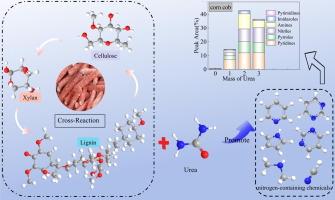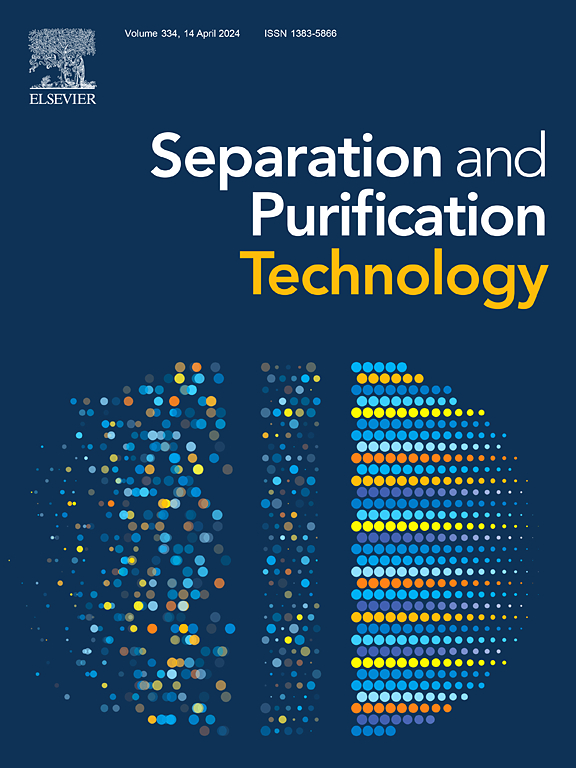三种成分富氮热解的协同效应和氮转化机制
IF 8.1
1区 工程技术
Q1 ENGINEERING, CHEMICAL
引用次数: 0
摘要
通过玉米芯和三种主要生物质成分(纤维素、木聚糖和木质素)与尿素的共热解,探索了含氮化学品(NCCs)生产的协同机制。与单独热解相比,共热解油的稳定性显著提高。这三种成分在共热解过程中表现出协同效应。木质素产生的酚类化合物与纤维素或木质素产生的吡喃化合物相互作用。特别是在尿素存在的情况下,这种交叉反应促进了含氮杂环(NHC)的形成。在 500 ℃ 时,玉米芯和尿素的共热解油中的 NCC 产量最高,达到 47.6 wt%。高浓度尿素促进了半纤维素和纤维素的热解,抑制了纤维素衍生产物与游离胺反应生成胺。焦炭的傅立叶变换红外分析表明,尿素的加入促进了玉米芯的分解,增强了 C-H 键的分解和脱氢反应。最后,提出了玉米芯和尿素共同热解过程中玉米芯热解油中主要 NHCs 是吡啶的潜在形成机制。本文的研究结果为通过生物质三种成分的协同作用从生物质中生产 NCCs 提供了理论支持。本文章由计算机程序翻译,如有差异,请以英文原文为准。

Synergistic effect of nitrogen-rich pyrolysis of three components and nitrogen transformation mechanism
The synergistic mechanism of nitrogen-containing chemicals (NCCs) production was explored from the co-pyrolysis of corn cob and the three major biomass components (cellulose, xylan, and lignin) with urea. Compared to individual pyrolysis, the stability of co-pyrolysis oil was significantly enhanced. The three components showed a synergistic effect during co-pyrolysis. The phenolic compounds generated from lignin interacted with the pyran compounds produced from cellulose or xylan. Especially in the presence of urea, this cross-reaction enhanced the formation of nitrogen-containing heterocycles (NHCs). At 500 ℃, the highest yield of NCCs was observed in the co-pyrolysis oil of corn cob and urea, reaching 47.6 wt%. The NHCs exhibited a selectivity of up to 96.9 wt%. the high concentration of urea promoted the pyrolysis of hemicellulose and cellulose, inhibiting the reaction between cellulose-derived products and free amines to form amines. FT-IR analysis of the char revealed that the addition of urea promoted the decomposition of corn cob, enhancing C–H bond breakdown and dehydrogenation reactions. Finally, a potential formation mechanism for The primary NHCs in corn cob pyrolysis oil was pyridine during the co-pyrolysis of corn cob and urea were proposed. The findings of this paper provide theoretical support for the production of NCCs from biomass through the synergistic interaction of its three components.
求助全文
通过发布文献求助,成功后即可免费获取论文全文。
去求助
来源期刊

Separation and Purification Technology
工程技术-工程:化工
CiteScore
14.00
自引率
12.80%
发文量
2347
审稿时长
43 days
期刊介绍:
Separation and Purification Technology is a premier journal committed to sharing innovative methods for separation and purification in chemical and environmental engineering, encompassing both homogeneous solutions and heterogeneous mixtures. Our scope includes the separation and/or purification of liquids, vapors, and gases, as well as carbon capture and separation techniques. However, it's important to note that methods solely intended for analytical purposes are not within the scope of the journal. Additionally, disciplines such as soil science, polymer science, and metallurgy fall outside the purview of Separation and Purification Technology. Join us in advancing the field of separation and purification methods for sustainable solutions in chemical and environmental engineering.
 求助内容:
求助内容: 应助结果提醒方式:
应助结果提醒方式:


